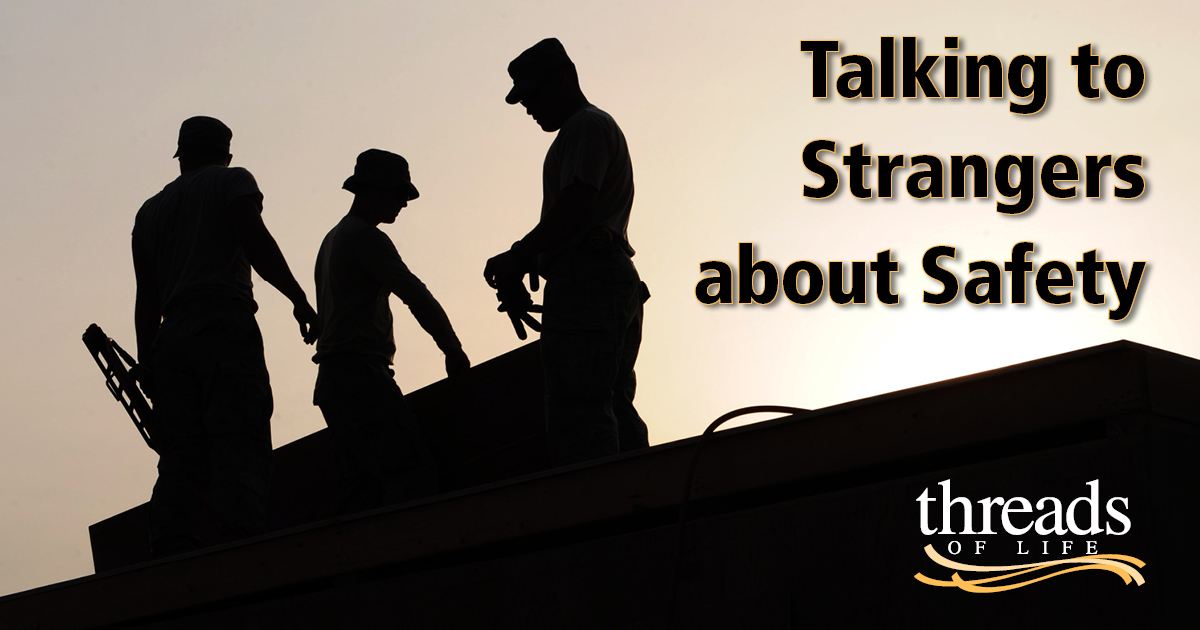(Posted on October 18, 2016)
 Most days, you don’t have to look far to spot safety problems all around you. The crew walking around on the neighbours’ roof with no fall protection. The young woman mowing grass for a company near your office, wearing running shoes and no hearing protection. The person at the store standing on the top step of a ladder to reach a light fixture.
Most days, you don’t have to look far to spot safety problems all around you. The crew walking around on the neighbours’ roof with no fall protection. The young woman mowing grass for a company near your office, wearing running shoes and no hearing protection. The person at the store standing on the top step of a ladder to reach a light fixture.
Knowing what we all know – as safety-minded people, or as families affected by workplace tragedies – you can’t not notice these things. And you can’t easily put them out of your mind once you’ve seen them.
So now what? Legally it’s not your responsibility to do something. None of us enjoy confrontation, and we don’t want to be busy-bodies or trouble-makers. But.
I had a friend who was great in these situations. I could point out the roofers across the street from our office, or the guys paving the parking lot, repairing their equipment while it’s running. Dwayne would go and talk to the workers. He would remind them that their wives or girlfriends or parents were expecting them home safe that night. He had a way of approaching people – they might be annoyed, but he generally got them to laugh, and nod, and do the right thing.
Without a Dwayne on hand, though, what’s the best way to tackle these situations? It may not always be wise or safe to walk onto a work site to report a safety concern.
Recently, some of Threads of Life’s staff and volunteers were attending a fundraiser when they saw a crew which was taking apart a temporary structure nearby. One worker was balancing across a centre beam, high above the ground, with no harness and no means at all either to prevent a fall or arrest a fall if it happened. After some debate, the Threads of Life folks (all wearing their bright green Threads of Life golf shirts) marched in to see the site manager. At first, he didn’t feel it was his place to do anything – the workers were sub-sub-contractors and not his employees. But he also knew who he was talking to, and what Threads of Life is all about, so it didn’t take much argument before he saw his responsibility. He made a call; the work stopped.
In any of these situations, we have no way of knowing what happens once we aren’t looking – maybe the workers go directly back to doing what they were doing before. Maybe a boss directs them to get back to work, and they don’t have a good option. But at least they’ve heard the message, and know that someone cared enough about their welfare to point out a danger.
And at least we’ve done something about what we’ve seen. Is that enough?
Today, we all feel a responsibility to do something if we suspect a child is being abused, or if we fear someone is at risk of harming himself or herself due to a mental illness. So what’s our moral responsibility, as regular citizens, for the safety of strangers?
Have you ever talked to strangers about safety? How have you responded when you saw something risky going on? Let’s share approaches that work!
- The State of Safety in Canada, 2024 - May 23, 2024
- Yes, you are making a difference. Thank you so much. - May 16, 2024
- Meet one of the families you’ll help through Steps for Life - February 1, 2024

 Find Support
Find Support Donate
Donate
This blog made me think of an instance this past summer when friends of ours were building a house. A young worker (the builder’s son) was cutting tile without hearing protection when we were visiting the work site. It was very noisy to say the least. I mentioned to the worker that he should have hearing protection on or he’d end up being deaf. He thought it was a joke!
I couldn’t get this unsafe situation out of my mind so the next day I went to the hardware store and bought a pair of earplugs and took them to the site. The young worker wasn’t there but the father was. I gave him the earplugs and said I couldn’t stop thinking about his son and his lack of hearing protection, that our son had died as a result of a workplace incident and I wanted him to think seriously about the safety of his workers. Who knows what the father or son will do in the future but I felt better knowing I had tried to point out that it’s the little things that accumulate that can cause a workplace tragedy.
Once you’ve seen something like this, it’s hard to sleep — but it also takes courage to step up and say something. Thanks, Marj, for sharing your story.
When roofers were beginning to replace roofs a few blocks from us, Fred noticed no one wore fall protection. He stopped and spoke with the boss and the boss insisted they did not need it, they were adept. Even after speaking about the dangers, the boss remained firm. Then Fred threatened to contact an inspector with Dept of Labour. He drove away, but on return trip later, he was relieved to see everyone wearing the fall protection. This continued each day as they replaced other roofs in the neighbourhood.
Thanks for sharing this, Liz – Fred’s persistence made a huge difference!